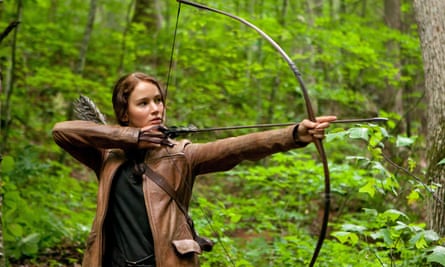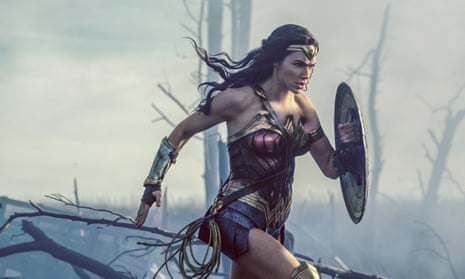The chances are you will read a feminist takedown of Wonder Woman before you see the film. And you’ll probably agree with it. Wonder Woman is a half-god, half-mortal super-creature; she is without peer even in superhero leagues. And yet, when she arrives in London to put a stop to the war to end all wars, she instinctively obeys a handsome meathead who has no skills apart from moderate decisiveness and pretty eyes. This is a patriarchal figment. Then, naturally, you begin to wonder why does she have to fight in knickers that look like a fancy letterbox made of leather? Does her appearance and its effect on the men around her really have to play such a big part in all her fight scenes? Even my son lodged a feminist critique: if she were half god, he said, she would have recognised the god Ares immediately – unless he were a better god than her (being a male god).
I agree with all of that, but I still loved it. I didn’t love it as a guilty pleasure. I loved it with my whole heart. Wonder Woman, or Diana Prince, as her civilian associates would know her, first appeared as a character in DC Comics in 1941, her creator supposedly inspired by the feminism of the time, and specifically the contraception pioneer Margaret Sanger. Being able to stop people getting pregnant would be a cool superpower, but, in fact, her skills were: bullet-pinging with bracelets; lassoing; basic psychology; great strength and athleticism; and being half-god (the result of unholy congress between Zeus and Hyppolyta). The 1970s TV version lost a lot of the poetry of that, and was just all-American cheesecake. Gal Gadot’s Wonder Woman made her cinematic debut last year in Batman v Superman, and this first live-action incarnation makes good on the character’s original premise, the classical-warrior element amped up and textured. Her might makes sense.
Yes, she is sort of naked a lot of the time, but this isn’t objectification so much as a cultural reset: having thighs, actual thighs you can kick things with, not thighs that look like arms, is a feminist act. The whole Diana myth, women safeguarding the world from male violence not with nurture but with better violence, is a feminist act. Casting Robin Wright as Wonder Woman’s aunt, re-imagining the battle-axe as a battler, with an axe, is a feminist act. A female German chemist trying to destroy humans (in the shape of Dr Poison, a proto-Mengele before Nazism existed) might be the most feminist act of all.
Women are repeatedly erased from the history of classical music, art and medicine. It takes a radical mind to pick up that being erased from the history of evil is not great either. Wonder Woman’s casual rebuttal of a sexual advance, her dress-up montage (“it’s itchy”, “I can’t fight in this”, “it’s choking me”) are also feminist acts. Wonder Woman is a bit like a BuzzFeed list: 23 Stupid Sexist Tropes in Cinema and How to Rectify Them. I mean that as a compliment.

Yet Wonder Woman is not a film about empowerment so much as a checklist of all the cliches by which women are disempowered. So it leaves you feeling a bit baffled and deflated – how can we possibly be so towering a threat that Hollywood would strive so energetically, so rigorously, for our belittlement? At the same time, you are conflicted about what the fightback should look like. Because, as every reviewer has pointed out, Wonder Woman is by no means perfect.
The woman who can fight is not new; from Sigourney Weaver’s Ripley in Alien, to Linda Hamilton’s Sarah Connor in The Terminator, this idea has a long pedigree. Connor was a far-fetched feminist figure because her power was concentrated in her ambivalent maternal love – like a hypothetical tiger mother, which doesn’t do a huge amount for female agency. She is still an accessory for male power, just on the other side of the mother/whore dichotomy. Ripley, being the same gender as her foe, recast action as a cat-fight, with all the sexist bullshit that entails (hot, sweaty woman saying “bitch” a lot – a classic pornography trope).
But the underlying problem is that the male fighter is conceived as an ego ideal for a male audience, who would imagine themselves in the shirt of Bruce Willis or mankini of Superman and get the referred thrill of their heroism. If you are still making the film for a male gaze, the female warrior becomes a sex object, and her fighting curiously random, like pole dancing – movement that only makes sense as display, and even then, only just. That was always the great imponderable of Lara Croft (as she appeared in the video-game, not the film): the listlessness of her combat, the slightly dreamlike quality of it. Even as it was happening, it was hard to remember why. When Angelina Jolie made her flesh, I thought she brought something subversive to the role; something deliberated, knowing and a bit scornful, as though looking into the teenage gamer’s soul and saying: “You don’t know whether that was a dragon, a dinosaur or a large dog. You are just hypnotised by my buttocks.”
The fighter as sex symbol stirs up a snakepit of questions: are you getting off on the woman or the violence? An unbreakable female lead can be liberating to the violent misogynist tendency since the violence against her can get a lot more ultra, and nobody has to feel bad about it, because she’ll win.

This is tackled head on in Wonder Woman. The tension, meanwhile, between the thrill of the action, which is what combat is all about, and the objectification, which is what women are all about, is referenced when Wonder Woman hurls someone across a room and an onlooker says: “I’m both frightened, and aroused.” A word on the fighting: there’s a lot of hurling, tons of lassoing, much less traditional fighting, where people harm one another with punches. This is becoming a sub-genre in films: “the kind of fighting that is ladylike”. It almost always involves bows and arrows, for which, as with so many things, we can thank Jennifer Lawrence in The Hunger Games. The way Lawrence fights is so outrageously adroit and natural that she makes it look as though women have been doing it all along, and men are only learning.
I find it impossible to imagine the feminist action-movie slam-dunk; the film in which every sexist Hollywood convention, every miniature slight, every outright slur, every incremental diss was slain by a lead who was omnipotent and vivid. That film would be long and would struggle for jokes. Just trying to picture it leaves you marvelling at the geological slowness of social progress in this industry, which finds it so hard to create female characters of real mettle, even when they abound in real life. Wonder Woman, with her 180 languages and her near-telepathic insights, would stand more chance of unpicking this baffler than Superman or Batman. But the answer, I suspect, lies in the intersection between the market and the culture; the more an art-form costs, the less it will risk, until the most expensive of them – blockbusters – can’t change at all. In an atmosphere of such in-built ossification, the courage of Wonder Woman is more stunning even than her lasso.

Comments (…)
Sign in or create your Guardian account to join the discussion